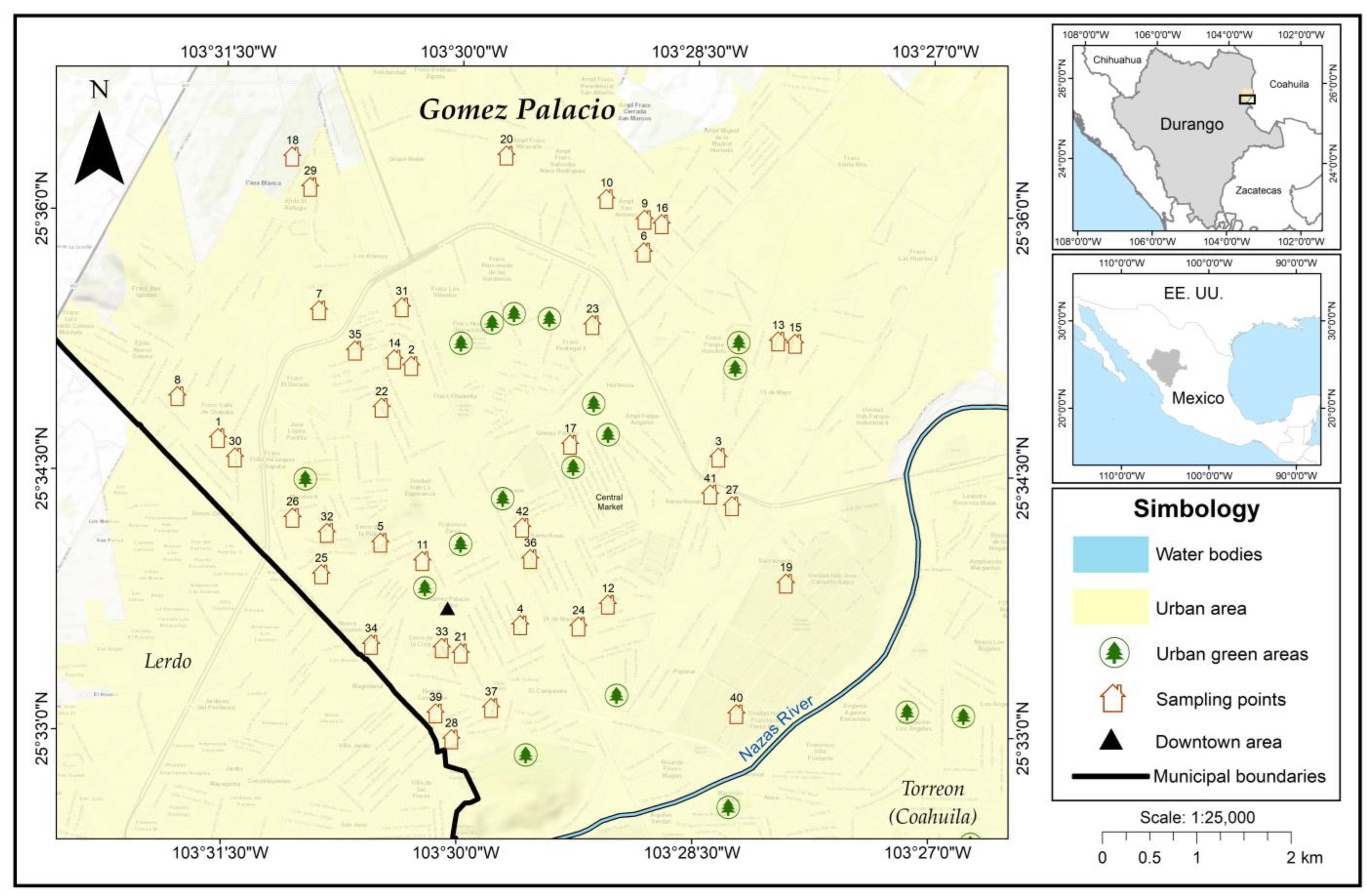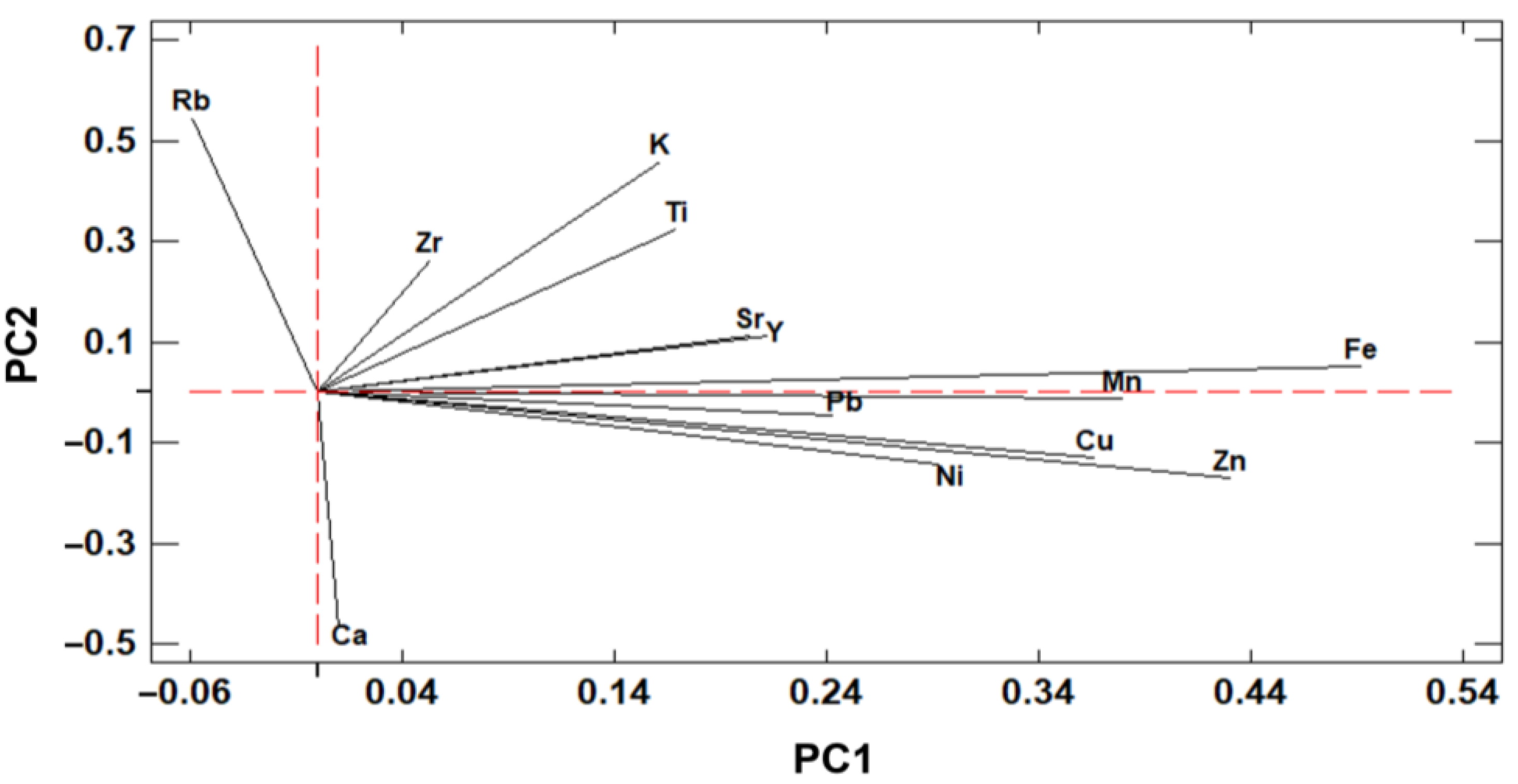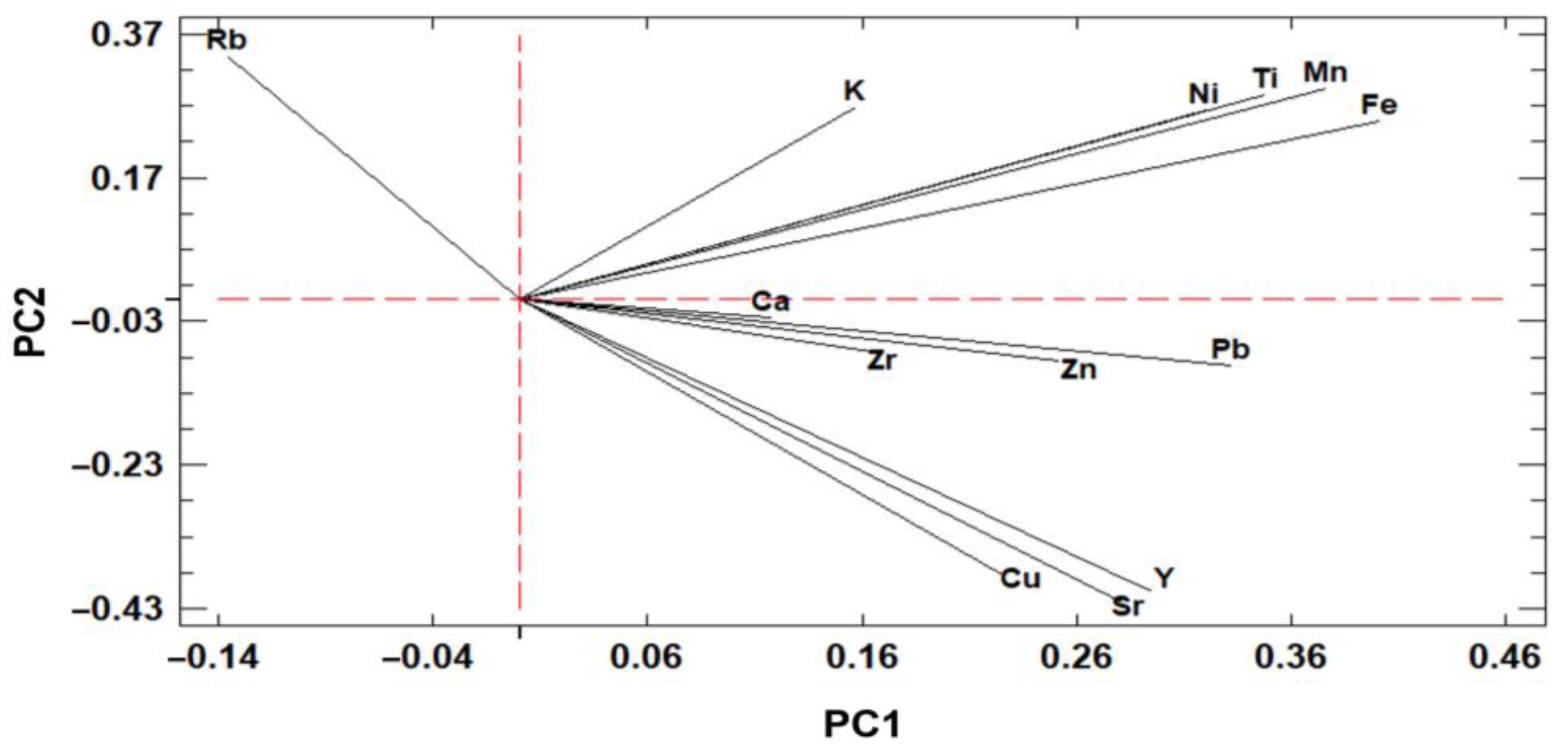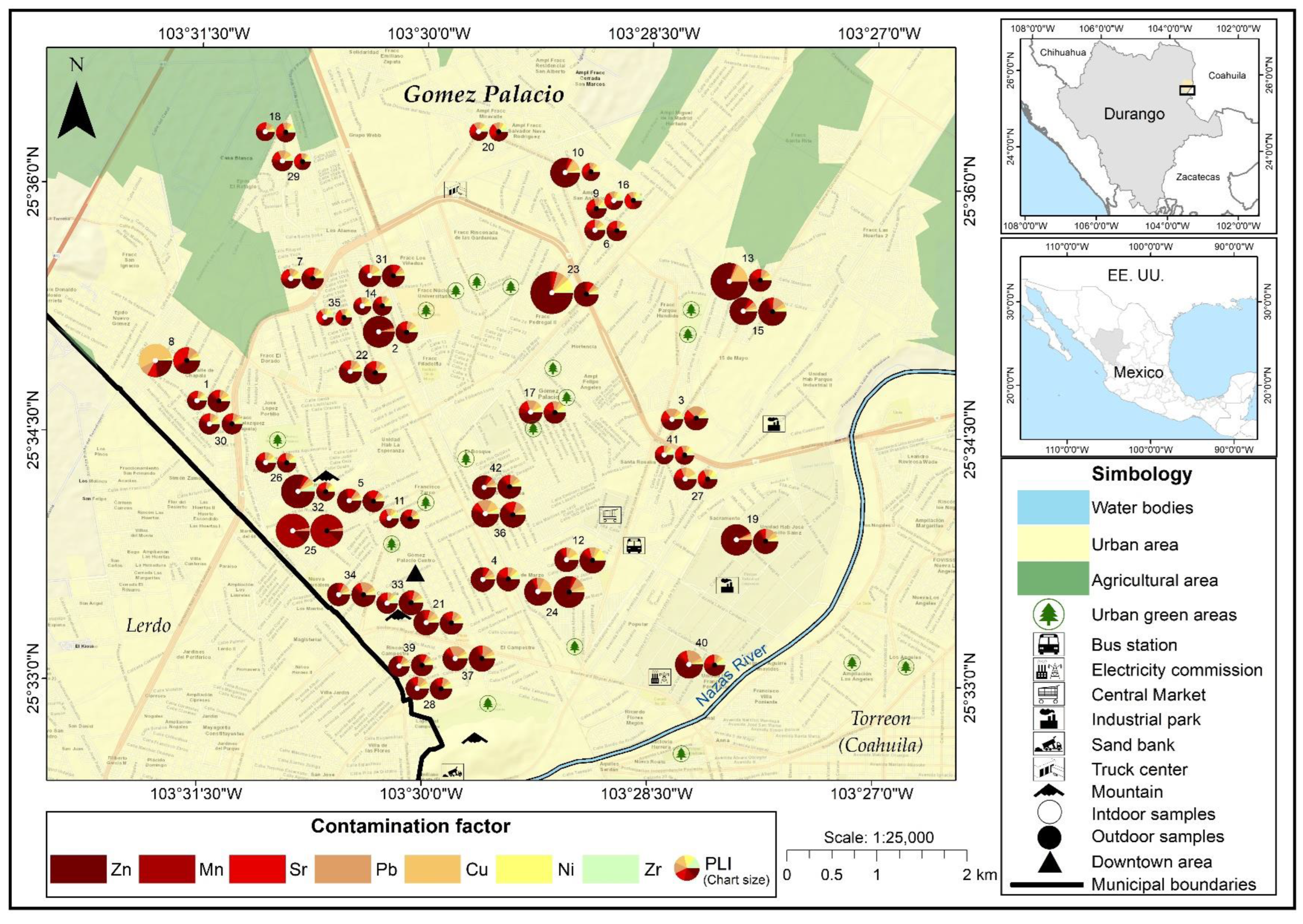Pollution Levels and Potential Health Risks of Potentially Toxic Elements in Indoor and Outdoor Dust during the COVID-19 Era in Gómez Palacios City, Mexico
Abstract
1. Introduction
2. Materials and Methods
2.1. Geochemical Analysis
2.2. Assessment of Pollution
2.3. Risk to Human Health
3. Results
3.1. Elements Indoors and Outdoors
3.2. Assessment of Pollution
3.3. Proposal of Pollution Limits
3.4. Site Evaluation
3.5. Human Health Risk Assessment
4. Discussion
| City | Cu | Mn | Pb | Zn | Fe |
|---|---|---|---|---|---|
| CDMX (n= 89) [5]. | 83 | 1075 | 190 | 291 | 74,100 |
| Ensenada (n = 86) [52] | 37 | 568 | 39 | 101 | 37,700 |
| Mérida (n = 101) [53] | 21 | 234 | 34 | 95 | 12,400 |
| Morelia (n = 100) [54] | 30 | 366 | 39 | 92 | 18,050 |
| SLP (n = 100) [55] | 87 | 424 | 163 | 207 | 26,650 |
| Toluca (n = 89) [5]. | 51 | 931 | 108 | 194 | 54,500 |
| This study Outdoor (n = 43) | 36 | 457 | 35 | 637 | 17,833 |
| This study Indoor (n = 43) | 51 | 388 | 47 | 948 | 17,589 |
5. Conclusions
Author Contributions
Funding
Institutional Review Board Statement
Informed Consent Statement
Data Availability Statement
Acknowledgments
Conflicts of Interest
References
- Coronaviridae Study Group of the International Committee on Taxonomy of Viruses. The species severe acute respiratory syndrome-related coronavirus: Classifying 2019-nCoV and naming it SARS-CoV-2. Nat. Microbiol. 2020, 5, 536–544. [Google Scholar] [CrossRef] [PubMed]
- Venter, Z.S.; Aunan, K.; Chowdhury, S.; Lelieveld, J. COVID-19 lockdowns cause global airpollution declines. Proc. Natl. Acad. Sci. USA 2020, 117, 18984–18990. [Google Scholar] [CrossRef] [PubMed]
- Sarmadi, M.; Rahimi, S.; Rezaei, M.; Sanaeri, D. Air quality index variation before and after the onset of COVID-19 pandemic: A comprehensive study on 87 capital, industrial and polluted cities of the world. Environ. Sci. Eur. 2021, 33, 134. [Google Scholar] [CrossRef] [PubMed]
- Gupta, V. Vehicle-generated heavy metal pollution in an urban environment and its distribution into various environmental components. In Environmental Concerns and Sustainable Development; Springer: Singapore, 2020; pp. 113–127. ISBN 978-981-13-5888-3. [Google Scholar]
- Aguilera, A.; Bautista, F.; Gutiérrez-Ruiz, M.; Ceniceros-Gómez, A.E.; Cejudo, R.; Goguitchaichvili, A. Heavy metal pollution of street dust in the largest city of Mexico, sources and health risk assessment. Environ. Monit. Assess. 2021, 193, 193. [Google Scholar] [CrossRef] [PubMed]
- Ferreira-Baptista, L.; De Miguel, E. Geochemistry and risk assessment of street dust in Luanda, Angola: A tropical urban environment. Atmos. Environ. 2005, 39, 4501–4512. [Google Scholar] [CrossRef]
- Wei, B.; Yang, L. A review of heavy metal contaminations in urban soils, urban road dusts and agricultural soils from China. Microchem. J. 2010, 94, 99–107. [Google Scholar] [CrossRef]
- Tchounwou, P.B.; Yedjou, C.G.; Patlolla, A.K.; Sutton, D.J. Heavy Metals Toxicity and the Environment. Exp. Suppl. 2012, 101, 133–164. [Google Scholar]
- Jan, A.T.; Azam, M.; Siddiqui, K.; Ali, A.; Choi, I.; Haq, Q.M.R. Heavy Metals and Human Health: Mechanistic Insight into Toxicity and Counter Defense System of Antioxidants. Int. J. Mol. Sci. 2015, 16, 29592–29630. [Google Scholar] [CrossRef]
- Hull, R.; Barbu, C.H.; Allen-Gil, S.; Borysova, O. Strategies to Enhance Environmental Security in Transition Countries; Springer: New York, NY, USA, 2007; p. 430. ISBN 978-1-4020-5996-4. [Google Scholar]
- Ibanez, Y.; Le Bot, B.; Glorennec, P. House-dust metal content and bioaccessibility: A review. Eur. J. Miner. 2010, 22, 629–637. [Google Scholar] [CrossRef]
- Kong, S.; Lu, B.; Bai, Z.; Zhao, X.; Chen, L.; Han, B.; Jiang, H. Potential threat of heavy metals in re-suspended dusts on building surfaces in oilfield city. Atmos. Environ. 2011, 45, 4192–4204. [Google Scholar] [CrossRef]
- Mohmand, J.; Eqani, S.A.M.A.S.; Fasola, M.; Alamdar, A.; Mustafa, I.; Ali, N.; Liu, L.; Peng, S.; Shen, H. Human exposure to toxic metals via contaminated dust: Bioaccumulation trends and their potential risk estimation. Chemosphere 2015, 132, 142–151. [Google Scholar] [CrossRef] [PubMed]
- Yoshinaga, J.; Yamasaki, K.; Yonemura, A.; Ishibashi, Y.; Kaido, T.; Mizuno, K.; Tanaka, A. Lead and other elements in house dust of Japanese residences–Source of lead and health risks due to metal exposure. Environ. Pollut. 2014, 189, 223–228. [Google Scholar] [CrossRef] [PubMed]
- Olujimi, O.; Steiner, O.; Goessler, W. Pollution indexing and health risk assessments of trace elements in indoor dusts from classrooms, living rooms and offices in Ogun State, Nigeria. J. Afr. Earth Sci. 2015, 101, 396–404. [Google Scholar] [CrossRef]
- Marcotte, S.; Estel, L.; Minchin, S.; Leboucher, S.; Le Meur, S. Monitoring of lead, arsenic and mercury in the indoor air and settled dust in the Natural History Museum of Rouen (France). Atmos. Pollut. Res. 2017, 8, 483–489. [Google Scholar] [CrossRef]
- Butte, W.; Heinzow, B. Pollutants in house dust as indicators of indoor contamination. Rev. Environ. Contam. Toxicol. 2002, 175, 1–46. [Google Scholar]
- Chen, G.; Wang, Y.; Li, S.; Cao, W.; Ren, H.; Knibbs, L.D.; Guo, Y. Spatiotemporal patterns of PM10 concentrations over China during 2005–2016: A satellite-based estimation using the random forests approach. Environ. Pollut. 2018, 242, 605–613. [Google Scholar] [CrossRef]
- Delgado-Iniesta, M.J.; Marín-Sanleandro, P.; Díaz-Pereira, E.; Bautista, F.; Romero-Muñoz, M.; Sánchez-Navarro, A. Estimation of Ecological and Human Health Risks Posed by Heavy Metals in Street Dust of Madrid City (Spain). Int. J. Environ. Res. Public Health 2022, 19, 5263. [Google Scholar] [CrossRef]
- Comisión Nacional para el Conocimiento y Uso de la Biodiversidad (CONABIO) y Secretaría de Recursos Naturales y Medio Ambiente de Durango (SRNYMA). La Biodiversidad en Durango. Estudio de Estado; CONABIO: Durango, México, 2017; pp. 16–30. ISBN 978-607-8328-97-0. [Google Scholar]
- Morales, J.; Aguilera, A.; Bautista, F.; Cejudo, R.; Goguitchaichvili, A.; Hernández-Bernal, M.S. Heavy metal content estimation in the Mexico City Street dust: An inter-method comparison and Pb levels assessment during the last decade. SN Appl. Sci. 2020, 2, 1841. [Google Scholar] [CrossRef]
- Lozano, R.; Bernal, J.P. Characterization of a new set of eight geochemical reference materials for XRF major and trace element analysis. Rev. Mex. Cien. Geol. 2005, 22, 329–344. [Google Scholar]
- Rout, T.K.; Masto, R.E.; Padhy, P.K.; Ram, L.C.; George, J.; Joshi, G. Heavy metals in dusts from commercial and residential areas of Jharia coal mining town. Environ. Earth Sci. 2014, 73, 347–359. [Google Scholar] [CrossRef]
- Ihl, T.; Bautista, F.; Ruíz, F.R.C.; Delgado, M.D.C.; Owen, P.Q.; Aguilar, D.; Goguitchaichvili, A. Concentration of toxic elements in topsoils of the metropolitan area of Mexico City: A spatial analysis using ordinary kriging and indicator kriging. Rev. Int. Contam. Ambie. 2015, 31, 47–62. [Google Scholar]
- Kabata-Pendias, A. Trace Elements in Plants. In Trace Elements in Soils and Plants Fourth Edition; Kabata-Pendias, A., Ed.; CRC Press (Taylor and Francis Group): Boca Raton, FL, USA, 2010; pp. 93–122. ISBN 9781420093704. [Google Scholar]
- USEPA. Risk Assessment Guidance for Superfund (RAGS) Volume III-Part A: Process for Conducting Probabilistic Risk Assessment, Appendix B (Vol. III). U.S. Environmental Protection Agency, EPA 540-R02-002. United States 2001. Available online: http://www.epa.gov/sites/production/iles/2015-09/documents/rags3adt_complete.pdf (accessed on 3 September 2021).
- Lu, X.; Wu, X.; Wang, Y.; Chen, H.; Gao, P.; Fu, Y. Risk assessment of toxic metals in street dust from a medium-sized industrial city of China. Ecotoxicol. Environ. Saf. 2014, 106, 154–163. [Google Scholar] [CrossRef] [PubMed]
- Al-Madanat, O.; Jiries, A.; Batarseh, M.; Al-Nasir, F. Indoor and outdoor pollution with heavy metals in Al-Karak City. J. Int. J. Environ. Appl. Sci. 2017, 12, 131–139. [Google Scholar]
- Grigoratos, T.; Martini, G. Brake wear particle emissions: A review. Environ. Sci. Pollut. Res. 2015, 22, 2491–2504. [Google Scholar] [CrossRef]
- Li, X.; Poon, C.S.; Liu, P.S. Heavy metal contamination of urban soils and street dusts in Hong Kong. Appl. Geochem. 2001, 16, 1361–1368. [Google Scholar] [CrossRef]
- Yadav, I.C.; Devi, N.L.; Singh, V.K.; Li, J.; Zhang, G. Spatial distribution, source analysis, and health risk assessment of heavy metals contamination in house dust and surface soil from four major cities of Nepal. Chemosphere 2019, 218, 1100–1113. [Google Scholar] [CrossRef]
- Zhao, X.; Li, Z.; Tao, Y.; Wang, D.; Huang, J.; Qiao, F.; Lei, L.; Xing, Q. Distribution characteristics, source appointment, and health risk assessment of Cd exposure via household dust in six cities of China. Build. Environ. 2020, 172, 106728. [Google Scholar] [CrossRef]
- Lin, Y.S.; Fang, F.M.; Wang, F.; Xu, M.L. Pollution distribution and health risk assessment of heavy metals in indoor dust in Anhui rural, China. Environ. Monit. Assess. 2015, 187, 565. [Google Scholar] [CrossRef]
- Zhou, L.; Liu, G.J.; Shen, M.C.; Hu, R.Y.; Sun, M.; Liu, Y. Characteristics and health risk assessment of heavy metals in indoor dust from different functional areas in Hefei, China. Environ. Pollut. 2019, 251, 839–849. [Google Scholar] [CrossRef]
- Latif, M.T.; Othman, M.R.; Kim, C.L.; Murayadi, S.A.; Sahaimi, K.N.A. Composition of household dust in semi-urban areas in Malaysia. Indoor Built Environ. 2009, 18, 155–161. [Google Scholar] [CrossRef]
- Praveena, S.M.; Abdul Mutalib, N.S.; Aris, A.Z. Determination of heavy metals in indoor dust from primary school (Sri Serdang, Malaysia): Estimation of the health risks. Environ. Forensics 2015, 16, 257–263. [Google Scholar] [CrossRef]
- Rasmussen, P.E.; Subramanian, K.S.; Jessiman, B.J. A multi-element profile of housedust in relation to exterior dust and soils in the city of Ottawa, Canada. Sci. Total Environ. 2001, 267, 125–140. [Google Scholar] [CrossRef]
- Lin, Y.; Fang, F.; Wu, J.; Zhu, Z.; Zhang, D.; Xu, M. Indoor and outdoor levels, sources and health risk assessment of mercury in dusts from a coal-industry city of China. Hum. Ecol. Risk Assess. 2017, 25, 1028–1040. [Google Scholar] [CrossRef]
- Galán, E.; Romero, A. Contaminación de suelos por metales pesados. Macla Rev. Soc. Esp. Mineral. 2008, 10, 48–60. [Google Scholar]
- Rodríguez-Agudelo, Y.; Riojas-Rodríguez, H.; Ríos, C.; Rosas, I.; Sabido Pedraza, E.; Miranda, J.; Siebe, C.; Texcalac, J.L.; Santos-Burgoa, C. Motor alterations associated with exposure to manganese in the environment in Mexico. Sci. Total Environ. 2006, 368, 542–556. [Google Scholar] [CrossRef]
- Kong, S.; Lu, B.; Ji, Y.; Zhao, X.; Bai, Z.; Xu, Y.; Liu, Y.; Jiang, H. Risk assessment of heavy metals in road and soil dusts within PM2.5, PM10 and PM100 fractions in Dongying city, Shandong province, China. J. Environ. Monit. 2012, 14, 791–803. [Google Scholar] [CrossRef]
- Jadoon, W.; Khpalwak, W.; Chidya, R.C.G.; Abdel-Dayem, S.M.M.A.; Takeda, K.; Makhdoom, M.A.; Sakugawa, H. Evaluation of Levels, Sources and Health Hazards of Road-Dust Associated Toxic Metals in Jalalabad and Kabul Cities, Afghanistan. Arch. Environ. Contam. Toxicol. 2018, 74, 32–45. [Google Scholar] [CrossRef]
- Ali, M.U.; Liu, G.; Yousaf, B.; Abbas, Q.; Ullah, H.; Munir, M.A.M.; Fu, B. Pollution characteristics and human health risks of potentially (eco) toxic elements (PTEs) in road dust from metropolitan area of Hefei, China. Chemosphere 2017, 181, 111–121. [Google Scholar] [CrossRef]
- Ayala-Carrillo, M.; Farfán, M.; Cárdenas-Nielsen, A.; Lemoine-Rodríguez, R. Are Wildfires in the Wildland-Urban Interface Increasing Temperatures? A Land Surface Temperature Assessment in a Semi-Arid Mexican City. Land 2022, 11, 2105. [Google Scholar] [CrossRef]
- Sarim, M.; Jan, T.; Khattak, S.A.; Mihoub, A.; Jamal, A.; Saeed, M.F.; Soltani-Gerdefaramarzi, S.; Tariq, S.R.; Fernández, M.P.; Mancinelli, R.; et al. Assessment of the Ecological and Health Risks of Potentially Toxic Metals in Agricultural Soils from the Drosh-Shishi Valley, Pakistan. Land 2022, 11, 1663. [Google Scholar] [CrossRef]
- Aguilera, A.; Bautista-Hernández, D.; Bautista, F.; Goguitchaichvili, A.; Cejudo, R. Is the Urban Form a Driver of Heavy Metal Pollution in Road Dust? Evidence from Mexico City. Atmosphere 2021, 12, 266. [Google Scholar] [CrossRef]
- Hammer, M.S.A.; Van Donkelaar, R.V.; Martin, E.E.; McDuffie, A.; Lyapustin, A.M.; Sayer, N.; Hsu, N.C.; Levy, R.C.; Garay, M.J.; Kalashnikova, O.V.; et al. Effects of COVID-19 lockdowns on fine particulate matter concentrations. Sci. Adv. 2021, 7, 7670. [Google Scholar] [CrossRef] [PubMed]
- Martinho, V.J.P.D. Impacts of the COVID-19 Pandemic and the Russia–Ukraine Conflict on Land Use across the World. Land 2022, 11, 1614. [Google Scholar] [CrossRef]
- Gul, H.K.; Gullu, G.; Babaei, P.; Nikravan, A.; Kurt-Karakus, P.B.; Salihoglu, G. Assessment of house dust trace elements and human exposure in Ankara, Turkey. Environ. Sci. Pollut. Res. Int. 2022, 31, 1–18. [Google Scholar] [CrossRef]
- Kim, G.; Lee, H.S.; Seok Bang, J.; Kim, B.; Ko, D.; Yang, M.A. Current review for biological monitoring of manganese with exposure, susceptibility, and response biomarkers. J. Environ. Sci. Health part C 2015, 33, 229–254. [Google Scholar] [CrossRef] [PubMed]
- Järup, L. Hazards of heavy metal contamination. Br. Med. Bull. 2003, 68, 167–182. [Google Scholar] [CrossRef]
- Cortés, J.L.; Bautista, F.; Quintana, P.; Aguilar, D.; Goguichaishvili, A. The color of urban dust as an indicator of contamination by potentially toxic elements: The case of Ensenada, Baja California, Mexico. Rev. Chapingo Serie Cienc. Forest. Ambien. 2015, 21, 255–266. [Google Scholar] [CrossRef]
- Aguilar, Y.; Bautista, F.; Quintana, P.; Aguilar, D.; Trejo-Tzab, R.; Goguitchaichvili, A.; Chan-Te, R. Color as a New Proxy Technique for the Identification of Road Dust Samples Contaminated with Potentially Toxic Elements: The Case of Mérida, Yucatán, México. Atmosphere 2021, 12, 483. [Google Scholar] [CrossRef]
- Delgado, C.; Israde, I.; Bautista, F.; Gogichaishvili, A.; Márquez, C.; Cejudo, R.; Morales, J.; González, I. Metales pesados en suelos urbanos de Morelia, Michoacán: Influencia de los usos de suelo y tipos de vialidad. Cienc. Nicolaita 2015, 65, 120–138. [Google Scholar] [CrossRef]
- Aguilera, A.; Morales, J.J.; Goguitchaichvili, A.; García-Oliva, F.; Armendariz-Arnez, C.; Quintana, P.; Bautista, F. Spatial distribution of magnetic material in urban road dust classified by land use and type of road in San Luis Potosí, Mexico. Air Qual. Atmos. Health 2020, 13, 951–963. [Google Scholar] [CrossRef]
- Calderón-Garcidueñas, L.; Chávez-Franco, D.A.; Luévano-Castro, S.C.; Macías-Escobedo, E.; Hernández-Castillo, A.; Carlos-Hernández, E.; Franco-Ortíz, A.; Castro-Romero, S.P.; Cortés-Flores, M.; Crespo-Cortés, C.N.; et al. Metals, Nanoparticles, Particulate Matter, and Cognitive Decline. Front. Neurol. 2022, 12, 794071. [Google Scholar] [CrossRef] [PubMed]







| Sitio | n | Min | Max | Median | CV (%) | SDT | BD1 | BWS | |
|---|---|---|---|---|---|---|---|---|---|
| mg/kg | |||||||||
| Ca | Out | 43 | 10,673 | 233,944 | 123,718 | 28 | * | 71,332 | |
| In | 42 | 10,530 | 275,658 | 115,953 | 37 | ||||
| Cu | Out | 43 | 0.7 | 289 | 36 | 74 | * | 18.2 | 39 |
| In | 42 | 0.5 | 2931 | 51 | 248 | ||||
| Mn | Out | 43 | 138 | 225,339 | 457 | 588 | * | 295 | 488 |
| In | 42 | 120 | 185,347 | 388 | 637 | ||||
| Pb | Out | 43 | 15 | 464 | 35 | 106 | * | 22.6 | 27 |
| In | 42 | 14 | 354 | 47 | 86 | ||||
| Rb | Out | 43 | 40 | 150 | 97 | 15 | * | 65.7 | 68 |
| In | 42 | 19 | 160 | 89 | 27 | ||||
| Zn | Out | 43 | 82 | 37,945 | 637 | 268 | * | 204.4 | 70 |
| In | 42 | 66 | 40,532 | 948 | 192 | ||||
| Fe | Out | 43 | 11,403 | 67,209 | 17,833 | 28 | ns | 14,419 | |
| In | 42 | 7616 | 82,911 | 17,589 | 44 | ||||
| K | Out | 43 | 278 | 23,363 | 11,815 | 23 | ns | 10,163 | |
| In | 42 | 345 | 31,316 | 11,762 | 32 | ||||
| Ni | Out | 43 | 3 | 164 | 24 | 62 | ns | 17.3 | 29 |
| In | 42 | 8 | 621 | 24 | 169 | ||||
| Sr | Out | 43 | 79 | 2272 | 375 | 54 | ns | 301.0 | 175 |
| In | 42 | 83 | 1442 | 379 | 38 | ||||
| Ti | Out | 43 | 4 | 5236 | 2726 | 31 | ns | 2063.9 | 7038 |
| In | 42 | 0.6 | 11,904 | 2645 | 45 | ||||
| Y | Out | 43 | 20 | 194 | 30 | 69 | ns | 25.1 | 23 |
| In | 42 | 14 | 218 | 30 | 57 | ||||
| Zr | Out | 43 | 0.5 | 391 | 181 | 47 | ns | 67.6 | 263 |
| In | 42 | 0.2 | 1608 | 185 | 102 | ||||
| Ca | 0.12 | 0.01 | −0.18 | 0.22 | 0.12 | 0.09 | −0.38 | 0.14 | 0.10 | 0.15 | 0.09 | −0.13 |
| Cu | 0.41 | −0.09 | 0.19 | 0.33 | 0.71 | −0.48 | 0.25 | 0.09 | 0.28 | 0.78 | 0.11 | |
| 0.04 | Fe | 0.40 | 0.55 | 0.26 | 0.44 | 0.07 | 0.21 | 0.58 | 0.22 | 0.41 | 0.25 | |
| 0.81 | 0.00 | K | 0.38 | −0.08 | 0.09 | 0.56 | 0.05 | 0.34 | 0.06 | −0.05 | 0.15 | |
| 0.00 | 0.11 | 0.00 | Mn | 0.23 | 0.32 | 0.15 | 0.30 | 0.34 | 0.28 | 0.21 | 0.14 | |
| 0.00 | 0.00 | 0.00 | 0.00 | Ni | 0.29 | −0.26 | 0.10 | 0.01 | 0.07 | 0.33 | 0.04 | |
| 0.04 | 0.00 | 0.00 | 0.15 | 0.00 | Pb | −0.32 | 0.13 | 0.16 | 0.15 | 0.76 | 0.14 | |
| 0.12 | 0.00 | 0.00 | 0.12 | 0.00 | 0.00 | Rb | −0.10 | 0.22 | −0.11 | −0.43 | 0.09 | |
| 0.00 | 0.00 | 0.20 | 0.00 | 0.01 | 0.00 | 0.00 | Sr | 0.14 | 0.99 | 0.14 | 0.03 | |
| 0.01 | 0.00 | 0.00 | 0.39 | 0.00 | 0.08 | 0.02 | 0.08 | Ti | 0.16 | 0.13 | 0.22 | |
| 0.07 | 0.12 | 0.00 | 0.00 | 0.00 | 0.91 | 0.00 | 0.00 | 0.02 | Y | 0.16 | 0.05 | |
| 0.01 | 0.00 | 0.00 | 0.29 | 0.00 | 0.20 | 0.01 | 0.05 | 0.00 | 0.01 | Zn | 0.11 | |
| 0.13 | 0.00 | 0.00 | 0.34 | 0.00 | 0.00 | 0.00 | 0.00 | 0.01 | 0.03 | 0.01 | Zr | |
| 0.02 | 0.05 | 0.00 | 0.01 | 0.02 | 0.50 | 0.01 | 0.12 | 0.56 | 0.00 | 0.42 | 0.05 |
| Cu | Mn | Zn | Total | ||
|---|---|---|---|---|---|
| World soil background | |||||
| <1 | 45 | 70.6 | 0 | 330/100% | |
| 1 a 3 | 41.5 | 27.0 | 10.3 | 330/100% | |
| 3–6 | 7.0 | 0.3 | 15.2 | 330/100% | |
| 6 a 10 | 2.4 | 0 | 21.8 | 330/100% | |
| Mayor a10 | 3.6 | 2.1 | 52.7 | 330/100% | |
| Background decile 1 | |||||
| <1 | 10 | 10 | 10 | 330/100% | |
| 1 a 3 | 53.9 | 86.4 | 32.7 | 330/100% | |
| 3–6 | 21.8 | 1.2 | 30.3 | 330/100% | |
| 6 a 10 | 7.0 | 0.3 | 12.1 | 330/100% | |
| Mayor a 10 | 7.3 | 2.1 | 14.9 | 330/100% | |
| Element | Background Value | Recommended Investigation Level | Mandatory Investigation Level | Intervention Level |
|---|---|---|---|---|
| Mn | 295.0 | 295–816 | 816–1324 | >1324 |
| Zn | 204 | 204–611 | 611–1207 | >1207 |
| Cu | 18 | 18–48 | 48–95 | >95 |
| Ni | 17 | 17–50 | 50–98 | >98 |
| Pb | 23 | 23–67 | 67–131 | >131 |
| Fe | 14,419 | 14,992–36,003 | 36,003–82,342 | >82,348 |
| Ti | 2008 | 2008–5759 | 5759–7852 | >7852 |
| Sr | 297 | 297–863 | 863–1434 | >1434 |
| Rb | 62 | 62–144 | 144–153 | >153 |
| Y | 26 | 26–70 | 70–146 | >146 |
| Zr | 60 | 60–140 | 140–355 | >355 |
Disclaimer/Publisher’s Note: The statements, opinions and data contained in all publications are solely those of the individual author(s) and contributor(s) and not of MDPI and/or the editor(s). MDPI and/or the editor(s) disclaim responsibility for any injury to people or property resulting from any ideas, methods, instructions or products referred to in the content. |
© 2022 by the authors. Licensee MDPI, Basel, Switzerland. This article is an open access article distributed under the terms and conditions of the Creative Commons Attribution (CC BY) license (https://creativecommons.org/licenses/by/4.0/).
Share and Cite
Santoyo-Martínez, M.; Aguilera, A.; Gallegos, Á.; Puente, C.; Goguitchaichvili, A.; Bautista, F. Pollution Levels and Potential Health Risks of Potentially Toxic Elements in Indoor and Outdoor Dust during the COVID-19 Era in Gómez Palacios City, Mexico. Land 2023, 12, 29. https://doi.org/10.3390/land12010029
Santoyo-Martínez M, Aguilera A, Gallegos Á, Puente C, Goguitchaichvili A, Bautista F. Pollution Levels and Potential Health Risks of Potentially Toxic Elements in Indoor and Outdoor Dust during the COVID-19 Era in Gómez Palacios City, Mexico. Land. 2023; 12(1):29. https://doi.org/10.3390/land12010029
Chicago/Turabian StyleSantoyo-Martínez, Miguel, Anahí Aguilera, Ángeles Gallegos, Cristo Puente, Avto Goguitchaichvili, and Francisco Bautista. 2023. "Pollution Levels and Potential Health Risks of Potentially Toxic Elements in Indoor and Outdoor Dust during the COVID-19 Era in Gómez Palacios City, Mexico" Land 12, no. 1: 29. https://doi.org/10.3390/land12010029
APA StyleSantoyo-Martínez, M., Aguilera, A., Gallegos, Á., Puente, C., Goguitchaichvili, A., & Bautista, F. (2023). Pollution Levels and Potential Health Risks of Potentially Toxic Elements in Indoor and Outdoor Dust during the COVID-19 Era in Gómez Palacios City, Mexico. Land, 12(1), 29. https://doi.org/10.3390/land12010029









